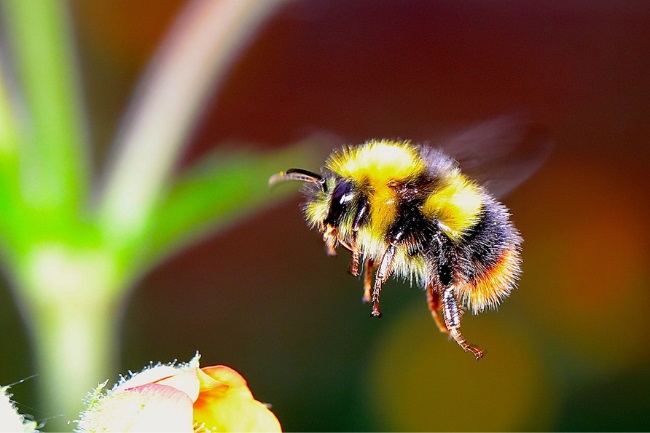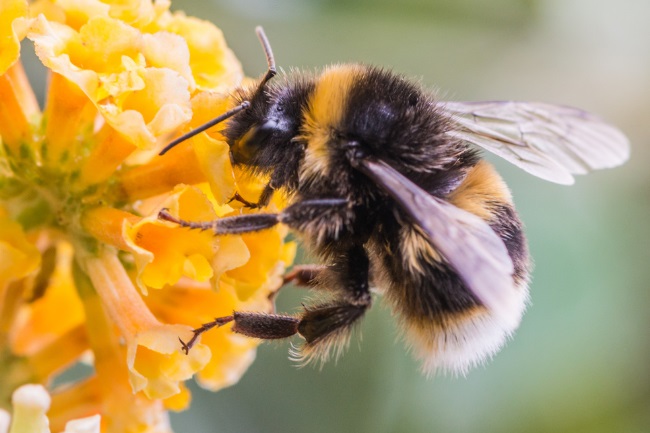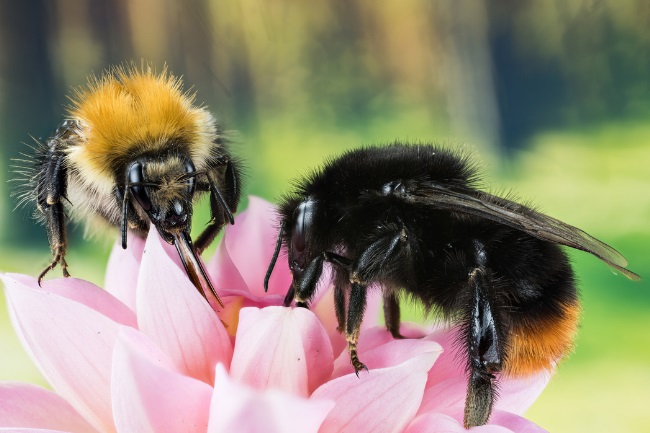Bumblebees are vegetarians, very specifically nectarivores. They eat pollen and nectar, and also make a type of honey by regurgitating and storing the nectar in their hives.
Contents
What is a bumblebee?

Bumblebees, as their name suggests, are a type of bee. They are flying insects, covered in dense fluffy looking hairs.
Like all insects their body is composed of three sections; the head, thorax and abdomen. Attached to the thorax they have six legs and two sets of wings. And on their head they have a set of antennae.
Like honeybees they live in a hive or nest, with a queen and many workers forming the heart of the colony, while drones and young queens are produced to head out and create the next generation.
Bumblebee nests only live for a year, dying as the winter sets in, the young queens entering diapause and emerging in the spring. Because their diet is so closely linked to flowers in temperate regions they must forage and eat as much as they can in the short flowering season.
Also read: How Many Eyes Does a Honey Bee Have? (Eyesight Explained)
What do bumblebees eat?

Bumblebees are nectavors, and rely on nectar and pollen from flowers to survive. It’s this dependence on flowers that makes them such great pollinators, as they move from flower to flower spreading pollen, which causes cross-pollination.
Most bumblebees will feed on a wide range of flower species, which is one of the things that has made them so successful.
| Food Source | Description |
|---|---|
| Nectar | Bumblebees primarily feed on the nectar of flowers. Nectar provides them with energy. |
| Pollen | Bumblebees collect pollen from flowers, which is a rich source of protein and nutrients. |
| Honeydew | Bumblebees may also feed on honeydew, a sugary substance secreted by certain insects. |
| Fruits and Juices | Occasionally, bumblebees may feed on ripe fruits or sugary juices for additional energy. |
| Sap and Tree Resin | Some bumblebees have been observed feeding on sap and tree resin for nutrients. |
When visiting a flower the bees will drink the energy-rich nectar, provided by the flower as a bribe to encourage insects to visit. They will then gather the pollen by brushing it from their furry bodies onto their hind legs, where special hairs help hold it in place.
You will often see these balls of pollen on the bee’s legs, looking like large yellow or orange lumps. This prevents them losing pollen as they fly around.
The queen bumblebee will be the first to be out and about collecting pollen, emerging in spring when the weather warms. At this point she doesn’t have any workers yet so she travels around feeding, building up her reserves.
Once she has eaten enough nectar and pollen, she will start to build her nest. Now it’s time to start stockpiling. She will create piles of pollen and build a waxy cup to regurgitate nectar into.
This nectar is often referred to as honey, but it doesn’t have the shelf life of honey as it hasn’t been reduced down to remove some of the water.
She will then lay eggs into her pollen store and incubate them till they hatch, feeding on her stored nectar. Once the young hatch, they will feed on the pollen.
As these workers grow, they will start to fetch the food for the hive. They will both feed on nectar straight from the flowers but also regurgitate some into wax pots for the queen, who does not leave the hive.
In general, the larvae will eat pollen, while the workers will focus more on the energy-rich nectar due to their difficult work. The queen will consume both, though often eating more pollen to keep up her strength for laying eggs.
When the young queens and drones are born, they will feed on the collected pollen and drink the gathered nectar to build up their strength for the task ahead.
When they head out into the world, they will gather their food directly from the flowers, eating the pollen and nectar straight away rather than gathering it up and taking it back to the hive.
Also read: Why are Bees Important to Plants? (Pollinators)
When do bumblebees eat?

Bumblebees, like many insects, will eat whenever they have the opportunity. Of course, immediately after eating, they may be too full, but otherwise, they don’t stick to set meal times.
Like all insects, bumblebees require an external heat source to function and therefore do not have the energy to move around much at night or in the winter. They may also stay still during cold, wet weather. As a result, you will often see insects hunkered down during a rainstorm.
Bumblebees, therefore, feed primarily when it’s warm and sunny. They struggle to fly in high winds or rain, so they may not be active in these conditions. Their food store in the hive allows them to feed when they can’t head out.
Unlike honeybees, bumblebees will die in the winter, meaning they do not store food to eat at this time. The young queens, the only ones to survive, will simply enter diapause during the winter and sleep away this challenging time of year.
How do bumblebees eat?

Bumblebees eat by using their perfectly adapted mouthparts to suck or chew up food. For example, in order to slurp up tasty nectar, they use a proboscis, which is a long tongue that acts as a straw. They can either choose to eat the nectar there and then or carry it back to their hive and regurgitate it for others to feast on.
For eating pollen, they utilise their mandibles, munching up it up much as we would eat. Having the combination of these different mouthparts allows them to take advantage of all the food a flower has to offer.
One thing that helps them to gather pollen is their fluffy bodies. These accumulate a positive charge as they fly, meaning the negatively charged pollen is drawn onto them as they land on the flower, like a balloon attracting pieces of wrapping paper with static electricity.
| Flower Type | Attracted to |
|---|---|
| Tubular Flowers | Bumblebees are particularly attracted to tubular flowers such as foxglove, honeysuckle, and penstemon. |
| Blue and Purple Flowers | Bumblebees are attracted to blue and purple flowers, including lavender, borage, and salvia. |
| Yellow Flowers | Bumblebees are also attracted to yellow flowers, such as sunflowers, daisies, and goldenrod. |
| Compound Flowers | Bumblebees prefer compound flowers with multiple florets, like dandelions and asters. |
They will comb much of this pollen into their pollen baskets in order to take it back to the hive, where hungry mouths are waiting.
Also read: When, How & What do Queen Bees Eat? (Explained)
What do bumblebees drink?
Though bees technically drink nectar, we tend to think of this more as a food than a drink, as it is such an important source of energy for the bees. Many insects rarely drink in the way that we humans do.
Nectar is very watery, and therefore they take on enough moisture from this to not need to drink additional sources of water. However, like many insects, they will occasionally drink from dew and raindrops if they have a need to, such as if the weather has been very hot and dry.
| Pollen and Nectar Preferences | Examples of Preferred Plants |
|---|---|
| Long-Tongued Bumblebees | Delphinium, honeysuckle, lupine, and red clover. |
| Short-Tongued Bumblebees | Daisies, asters, blackberries, and raspberries. |
| Bumblebees with Tongue Lengths in Between | Lavender, snapdragons, and catmint. |
You can provide thirsty bees with a drinking spot by placing pebbles in a shallow bowl of water, allowing them to safely go to the water’s edge and drink.
How to help a hungry bumblebee
Many of us want to help feed the bees; however, cooking up a batch of sugar water just isn’t particularly sustainable, especially once you think how many fuzzy faces you would be cooking for.
The best solution is to do some planting. Within your garden, you can plant bee-friendly flowers, such as foxglove, lavender and fleabane. Also, try to plant lots of native flowers, as these are more likely to have native insects that rely on them.
Early and late flowering plants are also essential to provide food at times of the year when not much is around. For example, ivy is a great late flower for bees, while primroses, bluebells and snowdrops are good early blooms.
If you have a lawn, why not leave part of it uncut, providing more flowers for bees and an excellent grassland habitat for many other species. In addition, long grass can be a great nesting site for bumblebees, as can old logs or compost piles.
Looking beyond your garden, trying to encourage your council to leave verges uncut, where it is safe to do so and to plant more flowers in public green spaces. Remember that not everywhere needs to be neat and tidy. Even a tumble of brambles provides excellent food for bees and a great place to nest.
The good news is there’s plenty you can do for hungry bees; just remember that the way a bee sees the world, and the way we see it, aren’t always the same. Beauty is, as ever, in the eye of the beholder.
Also read: Is Beekeeping Cruel? Does it Harm Bees?

